

News in 2023
|
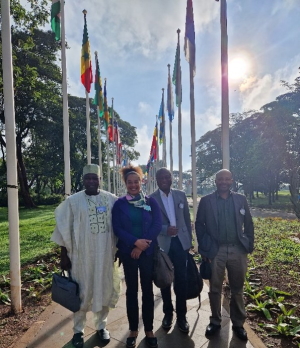 |
 |
UN Habitat Gigiri compound, Nairobi Kenya: attending the GLTN partners meeting
FIG President Diane Dumashie visited and collaborated with UN Habiat, Global Land Tool Network (GLTN) over the period April to October 2023 and connected with FIG members in Nairobi and London and facilitate engagement with GLTN network partners towards achieving GLTN mandate “Equal access to land and secure land rights for inclusive development”
Over 6 months activities have included
If you require further information to submit a project proposal do contact FIG President Dr Diane Dumashie (Co- chair GLTN Professional Cluster)
Highlights from each activity is described below in a longer report.

On 28th April, it was a pleasure to be welcomed by ISK, a long-standing FIG member and to be hosted by Mr Abraham Samoei President Institution of Surveyors Kenya (ISK), and senior team members including incoming President Mr Eric Nyadimo, CEO Rose Mwaura, Ayub Naburi and Joycelyn Makena Kaaria. We were able to discuss the potential for ISK to be involved in GLTN deliberations in the upcoming work phase IV (outlined in May, below)
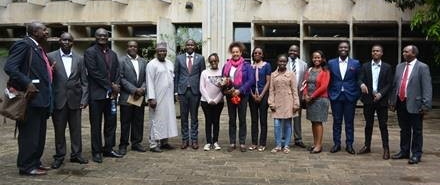
ISK introduction to University of Nairobi
In addition, ISK organised FIG President Diane Dumashie to provide a guest address to the University of Nairobi as hosted by Arch Peter Njeru; Chairman & Lecturer in the Department of Real Estate, Construction Management and Quantity Surveying, Faculty of the Built Environment & Design. Both Diane Dumashie and Kabir Muhamed, Chair of the FIG African Regional Network, were warmly welcomed.
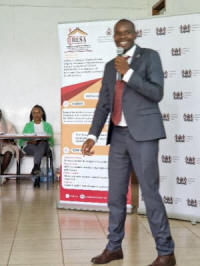 |
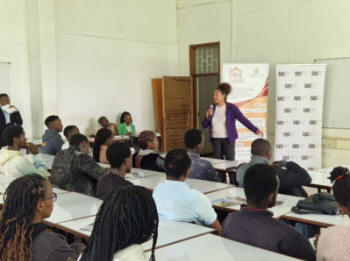 |
Abraham Samoei President Institution of Surveyors Kenya (ISK), FIG President D Dumashie
President Dumashie presented the FIG 2023- 2026 vision and mission to the undergraduates from the department of Real Estate, Construction Management and Quantity Surveying led by President of CRESA, A Muoki and department Geospatial & Space Technology represented by Chairman of GESA, Kelvin Nyabuti. The students welcomed the underlying FIG vision and direction to ‘leave no one behind’ and importantly that diversity across the generations is important in FIG endeavours.
Underscoring the depth of FIG membership over the years it was pleasing to meet Chairman of the Geospatial & Space Technology department, Dr David Siriba, a former FIG commission 3 active member. The juxta-positioning of space and geospatial is becoming increasingly prevalent as the FIG community is witnessing in its own platforms. Present and giving the vote of thanks was Nicky Nzioki, a Senior Lecturer, in the Faculty of the Built Environment & Design
It was also an honour that Joycelyn Kaaria Makena was able to initiate a meeting at the Kenya Lands Commission and introduce President Dumashie to the Chairperson, National Land Commission, Mr. Gershom Otachi where they discussed the importance of good land governance and the inevitable challenges.

GLTN partners meeting (part) Group Photo
Organised by GLTN and UN-Habitat, in collaboration with GLTN Partners the 9th GLTN Partner’s meeting was held over 4 days from 1-4 May, in the UN Compound in Gigiri, Nairobi, Kenya. This meeting is an opportunity to foster high level commitment to improve land management, empower and develop the capacities of land stakeholders and promote collaboration and coordination in the land sector.
Accordingly, the GLTN meeting had three activities: first and foremost the partners meeting, second the GLTN Steering committee meeting including the cluster meetings and third a GLTN Country Learning Exchange
1. The main theme of the Partners meeting was “Securing land tenure for all in a rapidly changing world.” The Meeting focussed on the lessons learnt from Phase 3 (2019-2023) and reflected on the way forward towards Phase 4 (2024-2027) of the GLTN programme.
The event gathered over 86 GLTN implementing partners representing organizations and institutions working on land at national, regional and global level. Attendance was mainly in person but hybrid was available for the main session with 147 attending
Opened by Michal Mlynar, UN Habitat Deputy Executive Director and chair of GLTN Steering committee the key note speakers included: Robert Lewis Lettington, GLTN, Key contemporary trends and their impact on land tenure security; Naome Kabanda, Ag. Director, Land Management, Ministry of Lands, Housing and Urban Development, Uganda: Delivering to the people: A Country perspective; Clarissa Augustinus, Senior Land Expert: The land and climate nexus.
Followed by perspectives from cluster co- chair: Grace Ananda, Policy and Advocacy Manager, Habitat from Humanity: Perspective of Civil Societies (CSOs) in Land Governance; S. Siraj Sait, University of East London: Perspectives from Training & Research and both Diane Dumashie, International Federation of Surveyors (FIG) and Rafic Khouri, Arab Union of Surveyors, provided perspective from Land Professionals,
Rafael Tuts, UN-Habitat representative, shared closing remarks.
He noted the dynamism and commitment of GLTN. He emphasized the significance of land tenure security and equitable access to land in the new urban agenda and sustainable development goals. He noted the role of land in financing development and empowering marginalized groups and the importance of land tenure security for community stability, prosperity, and resilience. Recognizing the connection between land and human rights, he affirmed UN-Habitat’s commitment to work with partners to achieve land tenure security and promote social inclusion. He thanked donors and partners for their contributions and looked forward to implementing Phase 4 of the programme”
2. The GTLN annual face-to- face Steering Committee meeting and the professional cluster meeting.
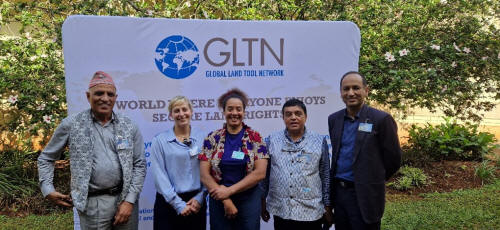
GLTN country Partners: Nepal, Austria
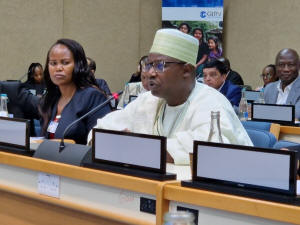 GLTN Steering Committee: K M Mansur takes the floor |
The Steering Committee is the governing body of the Network and headed by representative chairs, comprises members grouped into working clusters. These clusters include International Professional Bodies Cluster, International Training/Research Institutions Cluster, Rural International Civil Societies Cluster, and Urban International Civil Societies Cluster. In addition representatives from Bilateral and Multilateral Organizations are present. |
The Professionals Cluster annual meeting had 10 member representatives in-person, and 3 members attending virtually. The first main agenda was the election of the co- chairs, unopposed, FIG President Diane Dumashie and Rafic Khouri , Arab Union were re-elected for a further two years. The professional cluster hopes that a new co-chair will be identified at the next election thereby allowing one co- chairs will rotate with. FIG office continues to provide the important administrative support to the cluster and FIG President.
The second main agenda was a discussion and ideas for the upcoming GLTN phase 4. The cluster recommendation included climate change, prioritizing digitization efforts, continuing the use of STDM (Social Tenure Domain Model), organizing learning exchanges focused on country work, and addressing land degradation. Comments on the integration of young professionals and linkage with academia emerged.
3. The GLTN Country Learning Exchange is a platform to report the achievements and challenges of, and lessons learnt in the immediate past years. The one day event is an opportunity for different country partners to showcase their projects, learn from one another, assess the relevance of approaches adopted in different countries, recognise success so far and consolidate experiences and the lesson learnt.
GLTN and FIG provided brief opening remarks, followed by five country presentations (Nepal, Uganda, Palestine and DRC) showcasing their projects, followed by a further 3 (Philippines, Zambia and Namibia) before breakout groups deliberated further on implications for land policy development and implementation and improving land rights.
In his closing remarks to the very full 4 days of meetings, Robert Lewis Lettington expressed his immense pleasure at witnessing the reunion of the GLTN community in person and emphasized the importance of ongoing engagement, inviting partners to provide comments and suggestions and participate in as many GLTN meetings as possible.
“There is quite a lot coming up, the challenges that we face between now and 2030 are significant in keeping land on the agenda. And we all know that this can only be done by a sense of collective and coordinated action. So, thank you for all your contributions”.
Importantly a call to action for the professional cluster members is to consider and submit ideas for the next steering committee meeting scheduled for 23rd October 2023.
If you require further information to submit a project proposal do contact FIG President Dr Diane Dumashie (Co- chair GLTN Professional Cluster)
The full report can be viewed at
www.gltn.net/wp-content/uploads/2023/07/Report-of-the-9th-GLTN-Partners-Meeting-May-2023.pdf
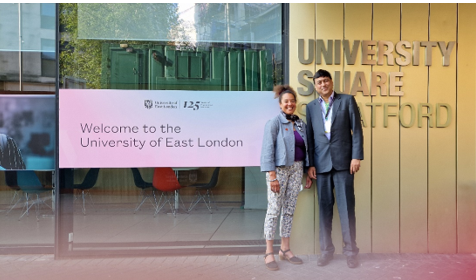
FIG president and Siraj Sait (UEL)
Strengthening women’s and girls land rights has long been recognised a critical component of eradicating poverty and reducing income and gender inequalities globally.
The EGM organized by the GLTN, University of East London (UEL), Huairou Commission and Namibia University of Science and Technology (KNUST#). Held at UEL, FIG President Diane Dumashie was invited along with the four clusters and GLTN partners attended the 3 day event.
Noting that gender and women’s rights have been at the core of GLTN since its formation (GLTN was launched in Vancouver in 2006) a GLTN Gender Strategy was prepared covering the period 2018-2030 (GGS) It aims to support national and local governments and other key stakeholders in fulfilling their obligation for inclusive development and meeting their SDGs commitments and human rights obligations on land and women’s tenure security.
It does this in a number of ways including, developing, testing, and promoting pro-poor and gender-responsive land management and land tenure tools. It advocates for establishment of a continuum of land rights, rather than just focusing on formal land titling processes. Additionally, it aims to improve global and regional coordination and by strengthening other key land actors and networks at various levels.
Formatted as a 3 day program, the EGM with a wide ranging agenda had an underlying focus to revisit the gender strategy to see the progress made so far; to update the gender strategy to make it Fit-for-Purpose; to sharpen the focus and propose how to move forward in addressing the diversity and different contexts of women and focus on vulnerable people, and acknowledge that we have not done much on youth and young people. But above all, to align with the upcoming GLTN phase 4 work program.
The consultation during this EGM will also serve to align with ongoing
initiatives such as the S4HL campaign and the Global Environment
Facility (GEF) collective commitment on land.
And, importantly the
FIG Commission 7 working group 7.5 ‘Women’s Access to land and S4HL”
(joint with C1 & Task force Agenda 2023/ SDG)
The lead GLTN partners and secretariat will be reporting later in the year
Dr D A Dumashie
FIG President
October 2023